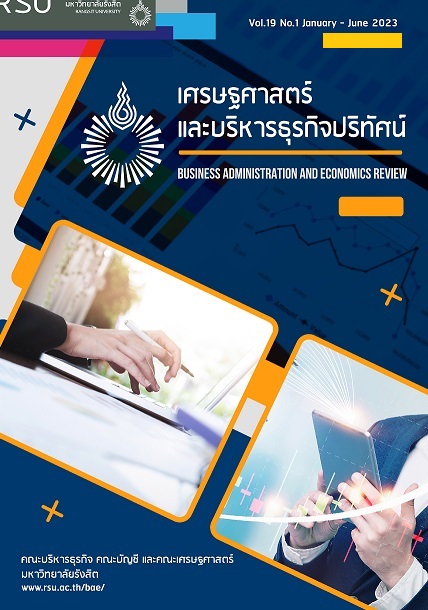Guidelines for the Developments of Logistics Operations Capability
Keywords:
Logistics, , Operations, Potential, Success, EntrepreneursAbstract
This research aimed to (1) examine the levels of logistics operations and (2) evaluate the levels of people capability in logistics operations. The information obtained was for logistic entrepreneurs and other interested parties. This was quantitative research. Simple random selection was used to choose samples of 350 informants for data collection. The tool for research was a questionnaire. For data analysis, descriptive statistics such as frequency, percentage, mean, and standard deviation were used, as well as inferential statistics such as the t-test, F-test, and regression analysis. The findings revealed that the majority of responders were men under 30 years old with a bachelor's degree and a salary between 20,000 and 30,000 baht, according to the data. They were an employee with between three and six years of experience. Customer service had the greatest average degree of logistics operations, followed by logistics and distribution and operations accordingly. Concerning employee potential, it was discovered that knowledge and competence were, on average, greater than operational expertise. At the 0.05 level of statistical significance, the testing of hypotheses revealed that gender, education, and income had varying effects on logistical operations based on personal aspects. All characteristics of the operating system and employee potential in terms of knowledge, competence, and expertise were statistically connected with the effectiveness of transportation logistics operations at a significance level of 0.05. Therefore, entrepreneurs should recognize the significance of empowering employees by promoting learning and exchanging operational information to develop the operating system, particularly the quality of services, in order to respond to the satisfaction of service recipients as precisely, rapidly, and cost-effectively as possible, given the organization's existing resources. This will provide the company sustained competitiveness.
References
Christopher, M.(1998). Logistics and Supply Chain Management: Strategies for Reducing Cost and Improving Service (2 Edition). London : Prentice Hall.
Division of Logistics, Department of Industrial Promotion (2020). Best practice & Lessons Learned. Retrieved from https://dol.dip.go.th/uploadcontent/DOL/FON/BP/Best_Practices_Full.pdf
George,M., Works, J. & Waston-Hemphill, K. (2005). Fast Innovation: Achieving Superior Differentiation, Speed to Market, and Increased Profitability. New York : McGraw Hill.
Grant, R. M. (1991). Contemporary Strategy Analysis : Concept, Techniques, Application. London: Basil Blackwell.
Grant, R.M. (2006). Fundamental of Logistics Management. Berkshire : McGraw.
Groysberg, B., & Abrahams, R. (2006). Lift Outs How to Acquire a High-Functioning Team. Harvard Business Review, 84(1), 133-140.
Kasirinch, C. (2019). Planning a Logistics System. Retrieved from http://www.cuti.chula.ac.th/twwwroot/journals/old/transj3/p8.pdf
Office of the National Economic and Social Development Council. (2019). Retrieved from https://www.nesdc.go.th/ewt_w3c/more_news.php?cid=564&filename=
The Third Thailand Logistics Development Plan (2017-2022). Retrieved from https://www.nesdc.go.th/ewt_dl_link.php?nid=6923&filename=logistic
Trade Policy and Strategy Office. (2020). Information. Retrieved from http://www.tpso.moc.go.th/th/node/9760
Vicari, S. (1998). Organizational Creativity: A New Perspective from Cognitive Systems Theory. Journal of Speech, Language, and Hearing Research, 41(5), 63-88
World Bank. (2020). Logistic Index. Retrieved from https://lpi.worldbank.org/
Downloads
Published
How to Cite
Issue
Section
License
Copyright (c) 2023 Business Administration and Economics Review

This work is licensed under a Creative Commons Attribution-NonCommercial-NoDerivatives 4.0 International License.
The contents in Business Administration and Economics Review can be used for publication. But do not modify, modify or use it for trade and profit.


